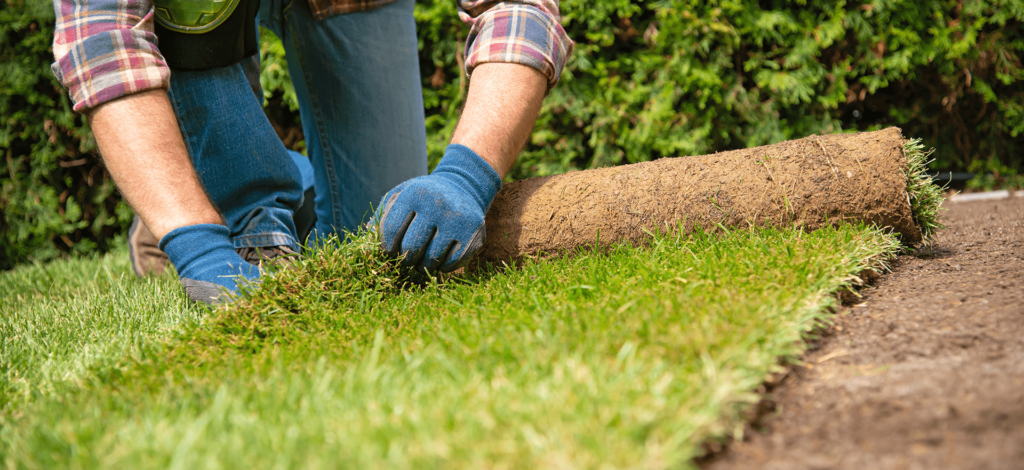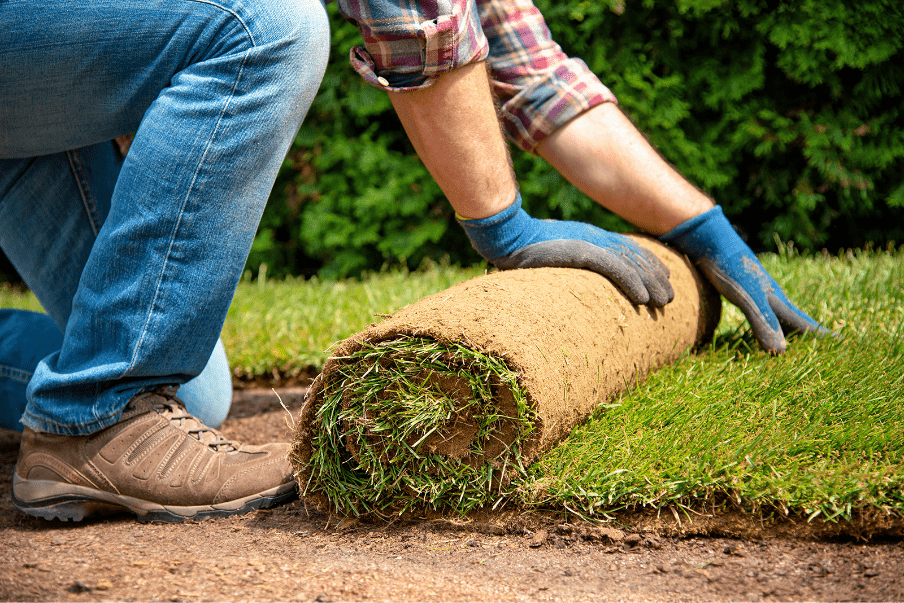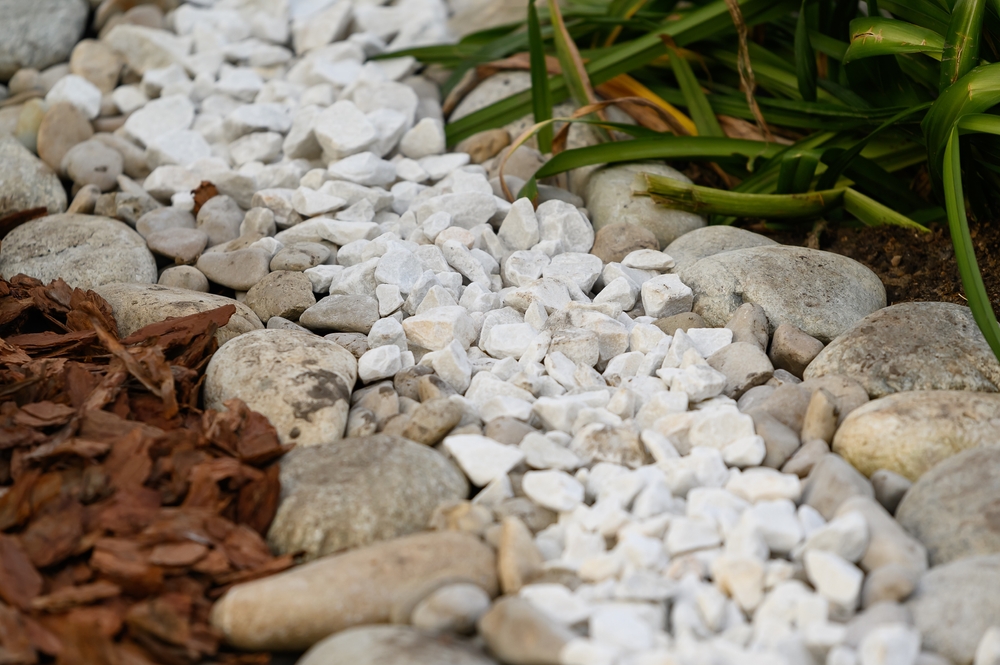How To Lay Sod In the Midwest: Tips For Homeowners
May 15, 2024
Category, Landscaping

Whether you’ve just purchased a new home or have finally decided that it’s time to spruce up your current property, choosing sod will provide you with an instant green space with none of the hassles of preparation, seeding, and waiting that comes with a traditional grass lawn.
Discover the benefits of professional sod installation in the Midwest.
Best Time to Lay Sod
Timing is important when it comes to establishing newly laid sod. Springtime is the optimal climate for installing sod in the Midwest due to more moderate temperatures and less frequent extreme weather than other seasons. However, cold-tolerant grasses like fescue sod may also be installed during the winter, though they may lay dormant until spring, which is completely normal. A sod installation professional will know how to lay sod properly and account for seasonal challenges.
Preparation of the Soil
Sod establishes best on healthy soil. Depending on the current state of the sod installation site, you’ll need to ensure the following soil preparation steps are met:
- Thoroughly clear the installation area of existing vegetation, rocks, and debris
- Grade and level soil, paying attention to low spots and high areas to ensure that sod can be laid evenly. Slope slightly away from buildings and structures for proper water drainage.
- Test pG level and nutrient content of the soil
- Add necessary soil amendments such as lime, sulfur, compost, or peat moss based on soil test results, to ensure optimal soil fertility
- Till the soil with a rototiller or garden fork to loosen the soil to a depth of 4-6 inches to improve aeration, drainage, and root penetrations
- Fertilize soil as necessary to add essential nutrients like nitrogen, phosphorus, and potassium, to promote root growth and establishment of the sod.
- Water the prepared soil to moisten it, but be sure to avoid overwatering
Selecting the Right Sod for the Midwest Climate
Many types of sod generally perform well in the Midwest. Locally-grown fescue sod is a popular choice because it is versatile and low maintenance and tolerates drought fairly well. The best sod for your lawn will depend on several factors including:
- Climate
- Type of soil
- Shade and sun levels in the installation area
- Amount of traffic your lawn gets
Step-by-Step Guide to Laying Sod
Laying sod may seem easy, but it must be done quickly and methodically to ensure that the sod does not dry out and can establish and attach itself to the soil. A professional sod installation company can ensure that all the steps are followed.
- Moisten soil right before you lay the sod.
- Unroll the first roll of sod along a long straight edge in your yard.
- Lay sod smoothly, avoiding wrinkles
- Don’t walk on the sod as it is laid.
- Lay additional rolls of sod right up against each other with no gaps or overlaps.
Watering Requirements After Installation
Freshly laid sod needs the right amount of water to establish its roots in the soil. Follow these guidelines for watering your sod during the first month after installation:
- Day of installation: Water the sod within an hour of installation for at least 45 minutes to help it attach to soil
- First week after installation: Water for 20 minutes at a time, 3 times a day, being mindful to qatar the outside edges of the lawn
- Second week: Water twice a day, making sure the soil and sod do not dry out
- Third and fourth weeks: Sod should get an inch of water a week, keeping it moist without overwatering
Initial Maintenance Tips
The first 6 months are important for sod maintenance. There are several things you can do to help your sod remain lush and healthy.
Dealing with uneven settling
If your sod looks bumpy or lumpy after installation, it’s best to contact a professional sod installation company to ensure you don’t damage the sod or its roots
Fertilizing
Avoid fertilizing your new sod lawn for the first month. After that time period, it’s advisable to consult with a sod maintenance expert in the Midwest to learn about the different organic and synthetic fertilizer options to select the best choices for your type of sod and the climate.
Mowing
How often and how tall you keep your lawn depends on the variety of sod you chose. Generally speaking, your lawn should be mowed every week or two. You should be mowing your new sod lawn more often during peak growing season, being careful to never cut more than ⅓ of the length in one session. Leave the grass a little taller during hot temperatures to avoid drying out. At the end of the growing season, leave the grass a bit taller.
Watering
Watering after the first month is similar to watering a traditional lawn. Look for signs of drought and consider investing in a quality irrigation system to ensure consistent and deep watering. Fescue sod is drought tolerant, so be sure to follow the recommended watering schedule for your sod.
Long-term Care for Sod
After the initial 6 months after sod installation, your lawn has established and should be cared for like a traditional lawn. This includes creating a seasonal lawn care schedule that includes:
- Irrigation
- Mowing
- Weeding
- Fertilizer
- Diagnosing lawn problems and disease
Common Mistakes to Avoid
Many homeowners attempt to save money with DIY sod installation and make some very basic but common mistakes.
- Improper soil preparation: Sod cannot thrive in poor soil
- Miscalculating how much sod you need
- Buying sod too early: if the sod sits for too long, it dries out
- Not watering enough: sod can dry out easily, especially in the early weeks
- Watering too much: too much moisture may cause mold, rot, or other awn diseases
- Mowing too soon: the sod’s roots may dislodge if mowed before the lawn is established
- Improper installation: gaps and bumps in the sod prevent it from establishing its roots in the soil
- Walking on sod too soon: sod needs undisrupted time to establish
Troubleshooting Tips for Common Issues
The best way to ensure that your sod establishes well on your lawn is to opt for professional sod installation and seasonal lawn care maintenance. Lawn issues can escalate quickly, so it’s important to be proactive in monitoring the health of your lawn. Try these solutions for the most common lawn issues in the Midwest:
- Enlist the help of a lawn care professional to handle regular lawn maintenance
- Make sure you have a reliable irrigation system and keep it maintained
- Mow lawn at proper heights
- Use reliable pest control practices
- Fertilize the lawn regularly
- Conduct regular soil tests and add amendments as needed
Get Professional Sod Installation In the Midwest
The best way to ensure proper installation of sod is to leave it to the experts. Get a free quote for sod installation for your Midwest home or business today.

